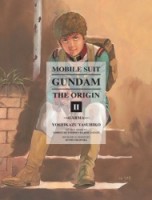 Creator: Yoshikazu Yasuhiko
Creator: Yoshikazu Yasuhiko
Original story: Yoshiyuki Tomino and Hajime Yatate
U.S. publisher: Vertical
ISBN: 9781935654988
Released: December 2013
Original release: 2008
Yoshikazu Yasuhiko’s manga series Mobile Suit Gundam: The Origin was my first real introduction to the massively popular Gundam franchise. I was somewhat hesitant to enter into the fray; Gundam can appear rather daunting to a newcomer considering the sheer number of series and alternate timelines involved. However, I was already a fan of Yasuhiko’s other manga. If I was going to start anywhere with Gundam it made sense for me to start with The Origin. So far, in my admittedly limited experience with the Gundam franchise, The Origin has been my favorite rendition of the story. The manga is a retelling of the original 1979 anime series with which Yasuhiko was also involved. Jaburo is the fourth volume in the collector’s edition of The Origin, initially published in Japan in 2008 and released in English by Vertical in 2013. The guest contributor for Jaburo was Yokusaru Shibata, which I believe makes it his manga debut in English.
After a far too brief stalemate in which fighting had all but ceased, the war between the self-proclaimed Principality of Zeon and the Earth Federation has quickly begun to escalate once more. Escaping from the destruction of the Federation’s Side 7 space colony, the ship White Base is carrying with it the Federation’s best hope to regain technological superiority over Zeon—the newly developed Gundam mobile suit. Crewed by a mix of civilians and inexperienced military personnel and doggedly pursued by some of Zeon’s finest commanders, White Base has surprisingly been able to persevere. The ship is drawing closer to Jaburo, the Federation’s headquarters on Earth, but the journey will still require passing through Zeon-occupied territory. The mission’s success and the crew’s survival will not only depend on their own inherent skills and talents but the support received from what remains of the Federation military and its dwindling resources.
While the war between Zeon and the Federation continues on a grand scale, Jaburo reveals some of the very personal reasons why the individual soldiers have chosen to fight that war and why some of the civilians have joined in the battle as well. Over the last couple of volumes in The Origin, Zeon has suffered several deaths of particular significance. Garma Zabi’s death has served as a rallying point for Zeon’s forces as a whole, but Ramba Ral’s death has triggered a much more aggressive vendetta from those who knew him best. They are less concerned with Zeon’s cause than they are with their own personal revenge. But neither side of the conflict is immune to the effects of war. In Jaburo, it’s the Federation and the crew of White Base who must face some severe losses of their own. Death and destruction has not been lacking in The Origin, but growing to know the characters, what they hold important, and what they are willing to die for make their demise even more potent.
In addition to the excellent character development found in Jaburo, I was also particularly impressed by Yasuhiko’s artwork in this volume. The color work is especially effective. In general, I have largely favored Yasuhiko’s black and white illustrations in The Origin, but the color artwork in Jaburo is simply gorgeous. The lush greens and blues of the Amazon and South America are beautiful, contrasting with the reds and oranges of fires and explosions as humankind continues to destroy itself. Yasuhiko’s black and white art in the series remains very strong as well and has a fantastic “old school” feel to it. The battles are fierce and dramatic, but Yasuhiko handles the chaos in a controlled manner that still retains a sense of pandemonium. The story has moved from space to Earth and so the technology, mobile suits, and strategies have to be adjusted for the new environment. Both the characters and Yasuhiko are aware of this, and it shows in Jaburo. I’m continuing to enjoy The Origin and look forward to reading more.



